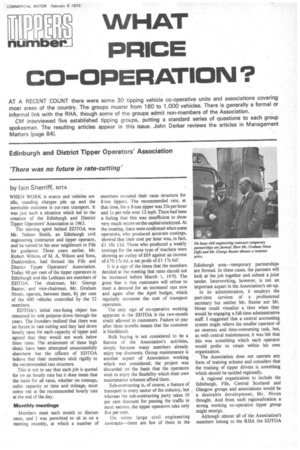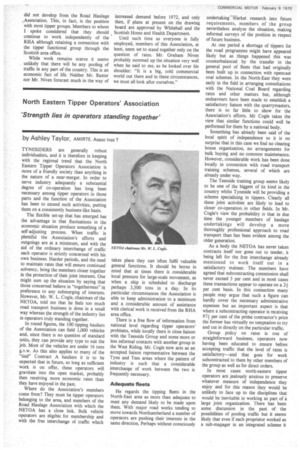WHAT PRICE CO-OPERATION ?
Page 49

Page 50

If you've noticed an error in this article please click here to report it so we can fix it.
Edinburgh and District Tipper Operators' Association 'There was no future in rate-cutting' by lain Sherriff, MITA
WHEN WORK is scarce and vehicles are idle, standing charges pile up and the inevitable outcome is cut-rate transport. It was just such a situation which led to the creation of the Edinburgh and District Tipper Operators' Association in 1963.
The moving spirit behind EDTOA was Mr. Nelson Smith, an Edinburgh civil engineering contractor and tipper operator, and he turned to his near neighbours in Fife for guidance. Three years earlier, Mr. Robert Wilson, of M. A. Wilson and Sons, Dunfermline, had formed the Fife and District Tipper Operators' Association. Today 90 per cent of the tipper operators in Edinburgh and the Lothians are members of EDTOA. The chairman, Mr. George Baxter,' and vice-chairman, Mr. Graham Niven, operate, between them, 81 per cent of the 600 vehicles controlled by the 52 members.
EDTOA's initial rate-fixing object has remained its sole purpose down through the years. The founders realized that there was no future in rate cutting and they laid down hourly rates for each capacity of tipper and agreed that they would not work below these rates. The attainment of these high ideals have been attempted unsuccessfully elsewhere but the officers of EDTOA believe that their members stick rigidly to the recommended rate structure.
This is not to say that each job is quoted for on an hourly rate but it does mean that the basis for all rates, whether on tonnage, cubic capacity or time and mileage, must come out at the recommended hourly rate at the end of the day.
Monthly meetings Members meet each month to discuss rates, and I was permitted to sit in on a meeting recently, at which a number of' members revealed their rates structure for 8-ton tippers. The recommended rate, at that time, for a 8-ton tipper was 35s per hour and Is per mile over 12 mph. There had been a feeling that this was insufficient to show very much return on the capital employed. At the meeting, fears were confirmed when some operators, who produced accurate costings, showed that their cost per hour was, in fact, £1 18s lid. Those who produced a weekly costings for the same type of machine were showing an outlay of £69 against an income of £70 17s 6d, a net profit of £1 17s 6c11 It is a sign of the times that the members decided at the meeting that rates should not be increased before March 1, 1970. The great fear is that customers will refuse to meet a demand for an increased rate now and again after the April budget, which regularly increases the cost of transport operation.
The only sign of co-operative working apparent in the EDTOA is the two-month credit allowed to customers. Failure to pay after three months means that the customer is blacklisted.
Bulk buying is not considered to be a feature of the Association's activities, simply because many members already enjoy top discounts. Group maintenance is another aspect of Association working which was considered; the project was discarded on the basis that the operators wish to enjoy the flexibility which their own maintenance schemes afford them.
Sub-contracting is, of course, a feature of transport in every sector of the industry, but whereas the sub-contracting party takes 10 per cent discount for passing the traffic in most sectors, the tipper operators take only five per cent.
On some large civil engineering contracts—there are few of these in the Edinburgh area—temporary partnerships are formed. In these cases, the partners will look at the job together and submit a joint tender. Interworking, however, is not an important aspect in the Association's set-up.
In its administration, it employs the part-time services of a professional secretary but neither Mr. Baxter nor Mr. Niven could visualize a time when they would be engaging a full-time administrative staff. I suggested that a central accounting system might relieve the smaller operator of an onerous and time-consuming task, but, as with central maintenance, it was felt that this was something which each operator would prefer to retain within his own organization.
The Association does not operate any form of training scheme and considers that the training of tipper drivers is something which should be tackled regionally.
A regional organization to include the Edinburgh, Fife, Central Scotland and Glasgow groups and associations would be a desirable development, Mr. Niven thought. And from such regionalization a strong working co-operative tipper group might emerge.
Although almost all of the Association's members belong to the RHA the EDTOA
did not develop from the Road Haulage :Association. This, in fact, is the position with most tipper groups. Members to whom I spoke considered that they should continue to work independently of the RHA although retaining a connection with the tipper functional group through the Scottish area office.
While work remains scarce it seems unlikely that there will be any. pooling of traffic in any part of the country. This is an economic fact of life. Neither Mr. Baxter nor Mr. Niven forecast much in the way of increased demand before 1972, and only then, if plans at present on the drawing board are approved by Whitehall and the Scottish Home and Health Department.
Until such time as everyone is fully employed, members of this Association, at least, seem set to stand together only on the question of rates. Mr. Graham Niven probably summed up the situation very well when he said to me, as he looked over his shoulder: "It is a big, cold commercial world out there and in these circumstances, we must all look after ourselves."


















































































































































